Exploring Factors Influencing Renewable Energy Diffusion in Commercial Buildings in Nigeria: A Grounded Theory Approach
Abstract
1. Introduction
2. Literature Review
2.1. Nigerian Context
2.2. RETs
3. Methodology
3.1. Sampling and Recruitment
3.2. Data Collection
3.3. Data Analysis
3.4. Quality
4. Results
4.1. Being Part of Us
4.2. Hostage Syndrome
4.3. Being Sheltered—Avoiding Responsibility
4.4. Following the Leader
4.5. Future-Proofing—Reflecting the Local Perspective
5. Discussion
6. Conclusions and Recommendations
- Make the inclusion of sustainable measures in new constructions mandatory (national policy); this could be done based on the type and size of the development, as well as by prioritising energy-driven retrofits to support a more circular economy.
- Create a more enabling environment and prevent/deter the procurement of substandard products by supporting self-help and innovative approaches by individuals, developers, and vendors interested in sustainable development. This would also create public awareness.
- ○
- Subsidise importation and other relevant fees, such as taxes and duties associated with specific sustainable technologies, products, and services.
- ○
- Implement quality standard initiatives such as awarding special licenses, alongside financial initiatives and creating and publishing a list of accredited vendors with star/quality ratings. This would create a more enabling environment and prevent/deter the procurement of substandard products, while also creating public awareness.
- ○
- Tap into external/international donors and schemes to obtain funding, e.g., clean development mechanisms, leapfrog funds, and scaling social initiatives.
- Formalise building codes and regularly review and update them to reflect the context and changing environment (climate and landscape), particularly as buildings constructed today will be around for years to come.
- Further research investigating designing for sustainability, copycatting for sustainability adoption, the suitability of foreign sustainability certification within the Nigerian context, and the need for a local Nigerian sustainability rating system.
- Create a sector-wide inventory of energy use in office buildings, including both on-grid and off-grid use and generation.
- Set up joint government–industry groups and advisory boards at both the local and national levels to develop strategies and action plans for awareness campaigns, workshops, and training sessions that will drive change and tolerance.
- Establish research bodies and/or knowledge repositories for construction research, which will aid in bridging the data/information deficit.
- Utilise professional conditions of engagement as a special purpose vehicle (SPV) for sustainability adoption. A similar approach is already employed by the regulatory financial body in Nigeria, with the implementation of sustainable banking principles (Deloitte, 2017) and through its adoption of RE in bank buildings.
Author Contributions
Funding
Institutional Review Board Statement
Informed Consent Statement
Data Availability Statement
Conflicts of Interest
References
- Omenihu, F.C.; Onundi, L.O.; Alkali, M.A. An Analysis of Building Collapse in Nigeria (1971–2016): Challenges for Stakeholders. Ann. Borno 2016, 26, 113–140. [Google Scholar]
- Osuizugbo, I.C. An Appraisal of Building Control and Regulations Practice in Nigeria: Project Managers’ Perspectives. Organ. Technol. Manag. Constr. 2019, 11, 2022–2033. [Google Scholar] [CrossRef]
- Sinha, A.; Gupta, R.; Kutnar, A. Sustainable Development and Green Buildings. Drv. Ind. 2013, 64, 45–53. [Google Scholar] [CrossRef]
- Sholanke, A.B.; Opeyemi, I.L.O. Implementation of Green Design Strategies by Architects in Southwest Nigeria. Int. J. Innov. Technol. Explor. Eng. 2019, 8, 431–438. [Google Scholar]
- Chel, A.; Kaushik, G. Renewable Energy Technologies for Sustainable Development of Energy Efficient Building. Alex. Eng. J. 2018, 57, 655–669. [Google Scholar] [CrossRef]
- Guerra, B.C.; Shahi, S.; Molleai, A.; Skaf, N.; Weber, O.; Leite, F.; Haas, C. Circular economy applications in the construction industry: A global scan of trends and opportunities. J. Clean. Prod. 2021, 324, 129125. [Google Scholar] [CrossRef]
- UNEP. 2021 Global Status Report for Buildings and Construction: Towards a Zero-Emissions, Efficient and Resilient Buildings and Construction Sector. Nairobi. 2021. Available online: www.globalabc.org (accessed on 10 November 2020).
- Mahpour, A. Prioritizing Barriers to Adopt Circular Economy in Construction and Demolition Waste Management. Resour. Conserv. Recycl. 2018, 134, 216–227. [Google Scholar] [CrossRef]
- Santamouris, M.; Vasilakopoulou, K. Present and Future Energy Consumption of Buildings: Challenges and Opportunities towards Decarbonisation. E-Prime-Adv. Electr. Eng. Electron. Energy 2021, 1, 100002. [Google Scholar] [CrossRef]
- World GBC. Bringing Embodied Carbon Upfront—Coordinated Action for the Building and Construction Sector to Tackle Embodied Carbon; World Green Building Council: London, UK, 2019; Available online: www.worldgbc.org/embodied-carbon (accessed on 10 November 2019).
- IEA. Africa Energy Outlook 2019: World Energy Outlook Special Report. 2019. Available online: www.iea.org/africa2019 (accessed on 6 December 2019).
- Adenle, A.A. Assessment of Solar Energy Technologies in Africa-Opportunities and Challenges in Meeting the 2030 Agenda and Sustainable Development Goals. Energy Policy 2020, 137, 111180. [Google Scholar] [CrossRef]
- Heinstein, P.; Ballif, C.; Perret-Aebi, L.E. Building Integrated Photovoltaics (BIPV): Review, Potentials, Barriers, and Myths. Green 2013, 3, 125–156. [Google Scholar] [CrossRef]
- IPCC. Climate Change 2007: Synthesis Report. Contribution of Working Group I, II, and III to the Fourth Assessment Report of the Intergovernmental Panel on Climate Change; IPCC: Geneva, Switzerland, 2007. [Google Scholar]
- IEA. Energy and Climate Change—World Energy Outlook Special Report. 2015. Available online: http://www.worldenergyoutlook.org/pressmedia/recentpresentations/150616_WEO_Climate_SLIDES.pdf (accessed on 30 July 2017).
- Curto, D.; Franzitta, V.; Guercio, A.; Panno, D. Energy Retrofit. A Case Study at Santi Romano Dormitory on the Palermo University. Sustainability 2021, 13, 13524. [Google Scholar] [CrossRef]
- Prasad, D.K.; Hall, M. The Construction Challenge: Sustainability in Developing Countries; Royal Institute of Chartered Surveyors: London, UK, 2005. [Google Scholar]
- Ugulu, A.I.; Aigbayboa, C. Motives for Solar Photovoltaic (PV) Adoption in Urban Nigeria. In Proceedings of the 4th International Conference on Research Methodology for Built Environment and Engineering. IOP Conference Series: Earth and Environmental Science, Bangkok, Thailand, 24–25 April 2019; p. 012012. [Google Scholar]
- Heathman, A. The Ta’u Island is powered entirely by solar panels and batteries thanks to SolarCity. Wired. 22 November 2016. Available online: https://www.wired.co.uk/article/island-tau-solar-energy-solarcity (accessed on 27 July 2022).
- Cervigni, R.; Rogers, J.A.; Henrion, M. Low-Carbon Development: Opportunities for Nigeria; Directions in Development; WorldBank: Washington, DC, USA, 2013. [Google Scholar]
- Africa Progress Panel. Power People Planet: Seizing Africa’s Energy and Climate Opportunities. Geneva. 2015. Available online: http://www.africaprogresspanel.org/wp-content/uploads/2015/06/APP_REPORT_2015_FINAL_low1.pdf (accessed on 15 November 2016).
- Goosen, M. Top 5 African Countries with the Most Green Energy Capacity. Energy Capital & Power. 3 December 2021. Available online: https://energycapitalpower.com/top-5-green-energy-africa-countries/ (accessed on 27 July 2022).
- Papathanasious, D. Renewables Are the Key to Green, Secure, Affordable Energy. World Bank Blogs. 21 June 2022. Available online: https://blogs.worldbank.org/energy/renewables-are-key-green-secure-affordable-energy?cid=ECR_TT_worldbank_EN_EXT (accessed on 28 July 2022).
- UN. Theme Report on Energy Access: Towards the Achievement of SDG 7 and Net-Zero Emissions. Nairobi. 2021. Available online: https://www.un.org/en/conferences/energy2021/about (accessed on 10 November 2020).
- Ohunakin, O.S.; Adaramola, M.S.; Oyewola, O.M.; Fagbenle, R.O. Solar Energy Applications and Development in Nigeria: Drivers and Barriers. Renew. Sustain. Energy Rev. 2014, 32, 294–301. [Google Scholar] [CrossRef]
- Rabetanetiarimanana, J.C.I.; Radanielina, M.H.; Rakotondramiarana, H.T. PV-Hybrid Off-Grid and Mini-Grid Systems for Rural Electrification in Sub-Saharan Africa. Smart Grid Renew. Energy 2018, 9, 171–185. [Google Scholar] [CrossRef]
- Usman, O.; Abdullah, K.; Mohammed, A. Estimating Electricity Consumption in the Commercial Sector of Nigeria’s Economy. Int. J. Recent Technol. Eng. 2019, 7, 1594–1600. [Google Scholar]
- Imandojemu, K.; Tonuchi, J.E. Contribution to the Empirics of Electricity Blackouts and Productivity in Nigeria. Energy Econ. Lett. 2021, 8, 60–69. [Google Scholar]
- The World Bank. Enterprise Survey of Business in Nigeria. 2014. Available online: http://www.enterprisesurveys.org/data/exploreeconomies/2014/nigeria#infrastructure (accessed on 10 November 2016).
- Anyanele, I.; Isamotu, O.; Akinde, B. Barriers and Opportunities to Operate Photovoltaic Systems in Commercial Buildings in Nigeria. Environ. Res. Technol. 2019, 2, 183–190. [Google Scholar]
- Unuigbe, M.; Zulu, S.L.; Johnston, D. Renewable Energy Sources and Technologies in Commercial Buildings: Understanding the Nigerian Experience. Built Environ. Proj. Asset Manag. 2020, 10, 231–245. [Google Scholar] [CrossRef]
- Ugulu, A.I. Barriers and Motivations for Solar Photovoltaic (PV) Adoption in Urban Nigeria. Int. J. Sustain. Energy Plan. Manag. 2019, 21, 19–34. [Google Scholar]
- Adesanya, A.A.; Pearce, J.M. Economic Viability of Captive Off-Grid Solar Photovoltaic and Diesel Hybrid Energy Systems for the Nigerian Private Sector. Renew. Sustain. Energy Rev. 2019, 114, 109348–109356. [Google Scholar] [CrossRef]
- Mu’azu, A.I. Sustainable Design Strategy: Assessment of the Impact of Design Variables on Energy Consumption of Office Buildings in Abuja. Ph.D. Thesis, University of Portsmouth, Portsmouth, UK, 2015. [Google Scholar]
- Charmaz, K. Constructing Grounded Theory, 2nd ed.; SAGE Publications Ltd.: London, UK, 2014. [Google Scholar]
- Flick, U. Doing Grounded Theory—The Sage Qualitative Research Kit; SAGE Publications Ltd.: Thousand Oaks, CA, USA, 2018. [Google Scholar]
- Urquhart, C.; Fernández, W. Using Grounded Theory Method in Information Systems: The Researcher as Blank Slate and Other Myths; Palgrave Macmillan: Cham, Switzerland, 2016; Volume 1, pp. 129–156. [Google Scholar]
- Adesanya, A.A.; Schelly, C. Solar PV-Diesel Hybrid Systems for the Nigerian Private Sector: An Impact Assessment. Energy Policy 2019, 132, 196–207. [Google Scholar] [CrossRef]
- Akhator, P.E.; Obanor, A.I.; Sadjere, E.G. Electricity Situation, and Potential Development in Nigeria Using Off-Grid Green Energy Solutions. J. Appl. Sci. Environ. Manag. 2019, 23, 527–537. [Google Scholar] [CrossRef]
- Mas’ud, A.A.; Vernyuy Wirba, A.; Muhammad-Sukki, F.; Mas’ud, I.A.; Munir, A.B.; Md Yunus, N. An Assessment of Renewable Energy Readiness in Africa: Case Study of Nigeria and Cameroon. Renew. Sustain. Energy Rev. 2015, 51, 755–784. [Google Scholar] [CrossRef]
- Babatunde, O.M.; Adedoja, O.S.; Babatunde, D.E.; Denwigwe, I.H. Off-grid Hybrid Renewable Energy System for Rural Healthcare Centers: A Case Study in Nigeria. Energy Sci. Eng. 2019, 7, 676–693. [Google Scholar] [CrossRef]
- Oseni, M.O. Get Rid of It: To What Extent Might Improved Reliability Reduce Self-Generation in Nigeria? Energy Policy 2016, 93, 246–254. [Google Scholar] [CrossRef]
- IEA. Energy Access Outlook 2017: From Poverty to Prosperity; IEA Publications: Paris, France, 2017. [Google Scholar]
- Obafemi, O.; Stephen, A.; Ajayi, O.; Abiodun, A.; Felix, I.; Mashinini, P.; Nkosinathi, M. Electric Power Crisis in Nigeria: A Strategic Call for Change of Focus to Renewable Sources. In Proceedings of the IOP Conference Series: Materials Science and Engineering, Ota, Nigeria, 9–13 July 2018. [Google Scholar]
- Osuizugbo, I.C.; Ojelabi, R.A. Building Production Management Practice in the Construction Industry in Nigeria. Eng. Manag. Prod. Serv. 2020, 12, 56–73. [Google Scholar] [CrossRef]
- Ajao, K.R.; Nangolo, A.A.; Adebo, F.; Ogunmokun, A.A.; Nangolo, F.; Adebo, E.O. Electricity Transmission Losses in Nigeria Power Sector: A Smart Grid Approach. ATBU J. Sci. Technol. Educ. JOSTE 2016, 4, 47–63. [Google Scholar]
- Barros, C.P.; Ibiowie, A.; Managi, S. Nigeria’s Power Sector: Analysis of Productivity. Econ. Anal. Policy 2014, 44, 65–73. [Google Scholar] [CrossRef]
- Ejiogu, A.R. A Nuclear Nigeria: How Feasible Is It? Energy Strategy Rev. 2013, 1, 261–265. [Google Scholar] [CrossRef]
- Oladipo, K.; Felix, A.A.; Bango, O.; Chukwuemeka, O.; Olawale, F. Power Sector Reform in Nigeria: Challenges and Solutions. In Proceedings of the IOP Conference Series: Materials Science and Engineering, Nanjing, China, 17–19 August 2018; p. 012037. [Google Scholar]
- Nwokocha, C.O.; Okoro, U.K.; Usoh, C.I. Photovoltaics in Nigeria—Awareness, Attitude and Expected Benefit Based on a Qualitative Survey across Regions. Renew. Energy 2018, 116, 176–182. [Google Scholar] [CrossRef]
- Bada, H.A. Managing the Diffusion and Adoption of Renewable Energy Technologies in Nigeria. In World Renewable Energy Congress; Linköping University Electronic Press: Linköping, Sweden, 2011; pp. 2642–2649. [Google Scholar]
- Shaaban, M.; Petinrin, J.O. Renewable Energy Potentials in Nigeria: Meeting Rural Energy Needs. Renew. Sustain. Energy Rev. 2014, 29, 72–84. [Google Scholar] [CrossRef]
- Enongene, K.E.; Abanda, F.H.; Otene, I.J.J.; Obi, S.I.; Okafor, C. The Potential of Solar Photovoltaic Systems for Residential Homes in Lagos City of Nigeria. J. Environ. Manag. 2019, 244, 247–256. [Google Scholar] [CrossRef] [PubMed]
- Ikudayisi, A.E. Sustainable and Renewable Energy Strategies in Residential Buildings in Akure, Nigeria. J. Energy Res. Rev. 2020, 5, 1–10. [Google Scholar] [CrossRef]
- Amankwah-Amoah, J. Solar Energy in Sub-Saharan Africa: The Challenges and Opportunities of Technological Leapfrogging. Thunderbird Int. Bus. Rev. 2015, 57, 15–31. [Google Scholar] [CrossRef]
- Nwofe, P.A. Potentials of Renewable Energy in a Developing Economy. Int. J. Adv. Res. 2014, 2, 334–342. [Google Scholar]
- Oyedepo, S.O. On Energy for Sustainable Development in Nigeria. Renew. Sustain. Energy Rev. 2012, 16, 2583–2598. [Google Scholar] [CrossRef]
- Oyedepo, S.O.; Babalola, O.P.; Nwanya, S.C.; Kilanko, O.; Leramo, R.O.; Aworinde, A.K.; Adekeye, T.; Oyebanji, J.A.; Abidakun, A.O.; Agberegha, O.L. Towards a Sustainable Electricity Supply in Nigeria: The Role of Decentralized Renewable Energy System. Eur. J. Sustain. Dev. Res. 2018, 2, 40–70. [Google Scholar] [CrossRef]
- Allu, E.; Ebohon John, O. Climate Change and Buildings in Nigeria: Lessons from a Field Survey. Acad. J. Sci. 2014, 3, 197–206. [Google Scholar]
- Haider, H. Climate Change in Nigeria: Impacts and Responses; K4D Helpdesk Report 675; Institute of Development Studies: Brighton, UK, 2019. [Google Scholar]
- Nkwunonwo, U.C.; Whitworth, M.; Baily, B. A Review and Critical Analysis of the Efforts towards Urban Flood Risk Management in the Lagos Region of Nigeria. Nat. Hazards Earth Syst. Sci. 2016, 16, 349–369. [Google Scholar] [CrossRef]
- Carter, K.; Fortune, C. Issues with Data Collection Methods in Construction Management Research. In Proceedings of the 20th Annual ARCOM Conference, Edinburgh, UK, 1–3 September 2004; pp. 939–946. [Google Scholar]
- Du Plessis, C. A Strategic Framework for Sustainable Construction in Developing Countries. Constr. Manag. Econ. 2007, 25, 67–76. [Google Scholar] [CrossRef]
- Unuigbe, M.; Zulu, S.; Johnston, D. Sustainability in the Nigerian Built Environment—A Scoping Study Review. In Proceedings of the 4th International Sustainable Ecological Engineering Design for Society (SEEDS) Conference, Dublin, Ireland, 6–7 September 2018; pp. 296–322. [Google Scholar]
- Dainty, A. A Review and Critique of Construction Management Research Methods. In Proceedings of the Construction Management and Economics 25th Anniversary Conference, Reading, UK, 16–18 July 2007; pp. 1533–1543. [Google Scholar]
- Murtagh, N.; Roberts, A.; Hind, R. The Relationship between Motivations of Architectural Designers and Environmentally Sustainable Construction Design. Constr. Manag. Econ. 2016, 34, 61–75. [Google Scholar] [CrossRef]
- Laryea, S.; Leiringer, R. Built Environment Research in West Africa: Current Trends and Future Directions. In Proceedings of the West Africa Built Environment Research (WABER) Conference, Abuja, Nigeria, 24–26 July 2012; pp. 797–804. [Google Scholar]
- Umeokafor, N.; Windapo, A.O. Understanding the Underrepresentation of Qualitative Research Approaches to Built Environment Research in Nigeria. Int. J. Constr. Educ. Res. 2018, 14, 198–217. [Google Scholar] [CrossRef]
- Karan, A.; Hansen, N. Does the Stockholm Syndrome Affect Female Sex Workers? The Case for a “Sonagachi Syndrome”. BMC Int. Health Hum. Rights 2018, 18, 10–12. [Google Scholar] [CrossRef] [PubMed]
- Katikiro, R.E. Prospects for the Uptake of Renewable Energy Technologies in Rural Tanzania. Energy Procedia 2016, 93, 229–233. [Google Scholar] [CrossRef]
- OECD. The DAC Guideline—Strategies for Sustainable Development: Guidance for Development Co-Operation. 2001. Available online: www.oecd.org (accessed on 28 January 2020).
- Lucchi, E.; Dall’Orto, I.; Peluchetti, A.; Toledo, L.; Pelle, M.; Polo Lopez, C.; Guazzi, G. Photovoltaic Technologies in Historic Buildings and Protected Areas: Comprehensive Legislative Framework in Italy and Switzerland. Energy Policy 2022, 162, 112772. [Google Scholar] [CrossRef]
- Trevarthen, M. Stakeholder Perceived Barriers to the Use of Solar Energy in Thailand’s Buildings. Ph.D. Thesis, Massey University, Palmerston North, New Zealand, 2011. [Google Scholar]
- Wieczorek, A.J. Sustainability transitions in developing countries: Major insights and their implications for research and policy. Environ. Sci. Policy 2018, 84, 204–216. [Google Scholar] [CrossRef]
- Ahlborg, H.; Hammar, L. Drivers and barriers to rural electrification in Tanzania and Mozambique—Grid-extension, Off-grid, and renewable energy technologies. Renew. Energy 2014, 61, 117–124. [Google Scholar] [CrossRef]
- Kolk, A.; Perego, P. Determinants of the adoption of sustainability assurance statements: An international investigation. Bus. Strategy Environ. 2010, 19, 182–198. [Google Scholar] [CrossRef]
- Rupt, G.V.; Bahri, P.A.; de Boer, K.; Mchenry, M.P. Barriers and opportunities of biogas dissemination in Sub-Saharan Africa and lessons learned from Rwanda, Tanzania, China, India, and Nepal. Renew. Sustain. Energy Rev. 2015, 52, 468–476. [Google Scholar]
- Glaser, B.G. Doing Grounded Theory: Issues and Discussions; Sociology Press: Mill Valley, CA, USA, 1998. [Google Scholar]
- Charmaz, K. Constructing Grounded Theory—A Practical Guide through Qualitative Analysis; Sage Publications Ltd.: Thousand Oaks, CA, USA, 2006. [Google Scholar]
- Torraco, R.J. Theory Development Research Methods. In Research in Organizations: Foundations and Methods of Inquiry; Swanson, R.A., Holton, E.F., III, Eds.; Berrett-Koehler Publishers, Inc.: Oakland, CA, USA, 2005; pp. 351–374. [Google Scholar]
- Morse, J.M. Sampling in Grounded Theory. In The SAGE Handbook of Grounded Theory, 1st ed.; Bryant, A., Charmaz, K., Eds.; SAGE Publications: Thousand Oaks, CA, USA, 2010; pp. 229–244. [Google Scholar]
- Coyne, I.T. Sampling in Qualitative Research. Purposeful and Theoretical Sampling; Merging or Clear Boundaries? J. Adv. Nurs. 1997, 26, 623–630. [Google Scholar] [CrossRef]
- Berg, B.L.; Lune, H.; Lune, H. Qualitative Research Methods for the Social Sciences, 5th ed.; Pearson Education, Inc.: Boston, MA, USA, 2004. [Google Scholar]
- Bryant, A. Grounded Theory and Grounded Theorizing: Pragmatism in Research Practice; Oxford University Press: New York, NY, USA, 2017. [Google Scholar]
- Dworkin, S.L. Sample Size Policy for Qualitative Studies Using In-Depth Interviews. Arch. Sex. Behav. 2012, 41, 1319–1320. [Google Scholar] [CrossRef]
- Glaser, B. Remodeling Grounded Theory. Hist. Soc. Res. 2004, 19, 47–68. [Google Scholar]
- Bryman, A. Social Research Methods, 5th ed.; Oxford University Press: Oxford, UK, 2016. [Google Scholar]
- Glaser, B.G.; Strauss, A.L. The Discovery of Grounded Theory; Aldine: Chicago, IL, USA, 1967. [Google Scholar]
- Birks, M.; Mills, J. Grounded Theory: A Practical Guide, 2nd ed.; Sage Publications Ltd.: London, UK, 2015. [Google Scholar]
- Denzin, K.D.; Lincoln, Y.S. The SAGE Handbook of Qualitative Research, 5th ed.; Sage: Thousand Oaks, CA, USA, 2018. [Google Scholar]
- Charmaz, K.; Bryant, A. Grounded Theory. In The Sage Handbook of Grounded Theory; Sage Publications Ltd.: Thousand Oaks, CA, USA, 2010; pp. 406–417. [Google Scholar]
- Liu, Z.; Beaver, K.; Speed, S. Being Healthy: A Grounded Theory Study of Help Seeking Behaviour among Chinese Elders Living in the UK. Int. J. Qual. Stud. Health Well-Being 2014, 9, 24820. [Google Scholar] [CrossRef] [PubMed][Green Version]
- Graham, D.L.; Rawlings, E.I.; Ihms, K.; Latimer, D.; Foliano, J.; Thompson, A.; Suttman, K.; Farrington, M.; Hacker, R. A Scale for Identifying “Stockholm Syndrome” Reactions in Young Dating Women: Factor Structure, Reliability, and Validity. Violence Vict. 1995, 10, 3–22. [Google Scholar] [CrossRef] [PubMed]
- Hirmer, S.; Cruickshank, H. The User-Value of Rural Electrification: An Analysis and Adoption of Existing Models and Theories. Renew. Sustain. Energy Rev. 2014, 34, 145–154. [Google Scholar] [CrossRef]
- Festinger, L. A Theory of Cognitive Dissonance. 2; Stanford University Press: Redwood City, CA, USA, 1957. [Google Scholar]
- Abrahamson, E. Managerial Fads and Fashions: The Diffusion and Rejection of Innovations. Manag. Rev. 1991, 16, 586–612. [Google Scholar]
- Dalibi, S.G.; Feng, J.C.; Shuangqin, L.; Sadiq, A.; Bello, B.S.; Danja, I.I. Hindrances to Green Building Developments in Nigeria’s Built Environment: “The Project Professionals’ Perspective”. In IOP Conference Series: Earth and Environmental Science; Binlin, D., Ed.; IOP Publishing Ltd.: Suzhou, China, 2017; Volume 63, pp. 1–8. [Google Scholar]
- Dwaikat, L.N.; Ali, K.N. Green buildings cost premium: A review of empirical evidence. Energy Build. 2016, 100, 396–403. [Google Scholar] [CrossRef]
- Weerasinghe, A.S.; Ramachandra, T. Implications of sustainable features on life-cycle costs of green buildings. Sustain. Dev. 2020, 28, 1136–1147. [Google Scholar] [CrossRef]

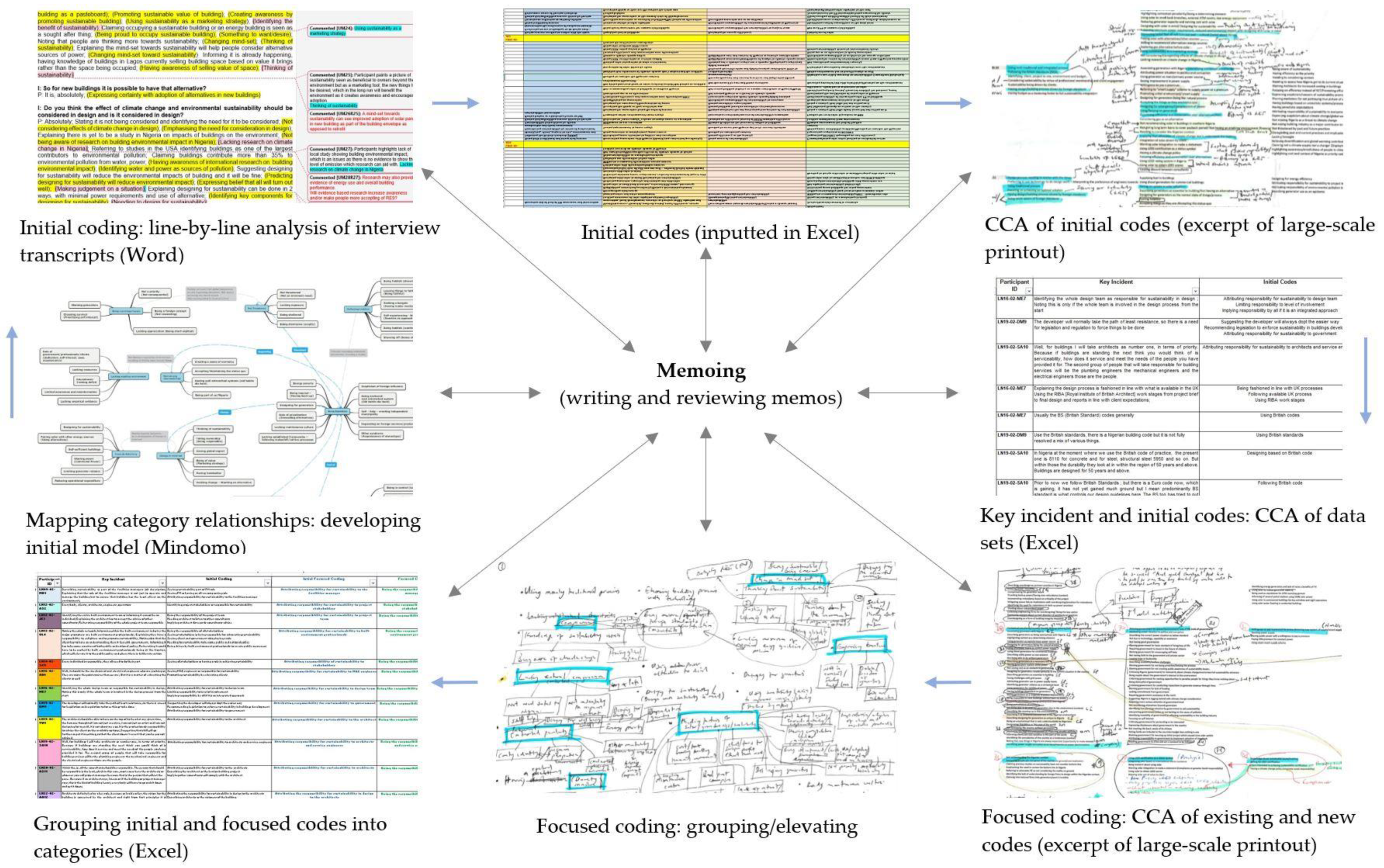

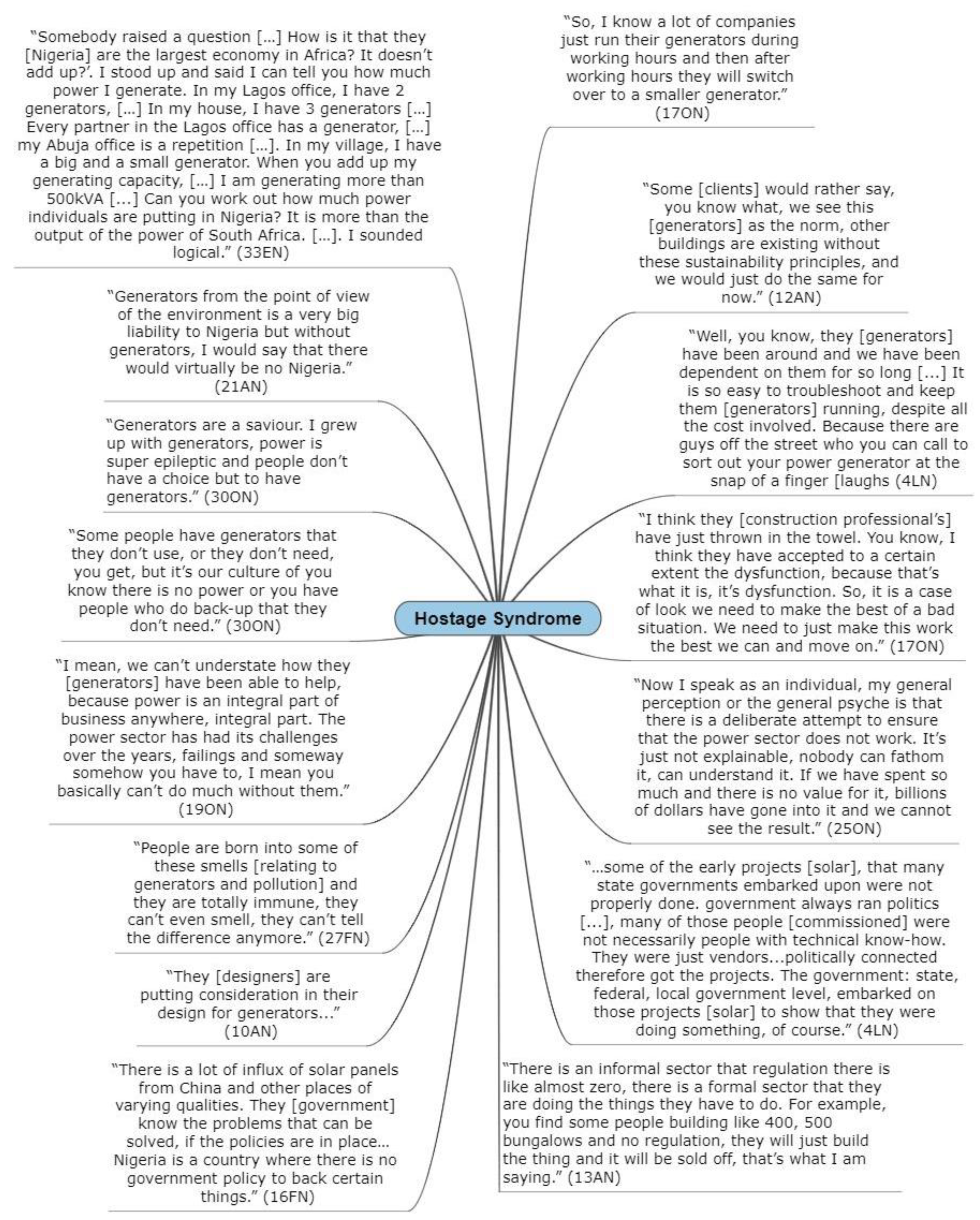
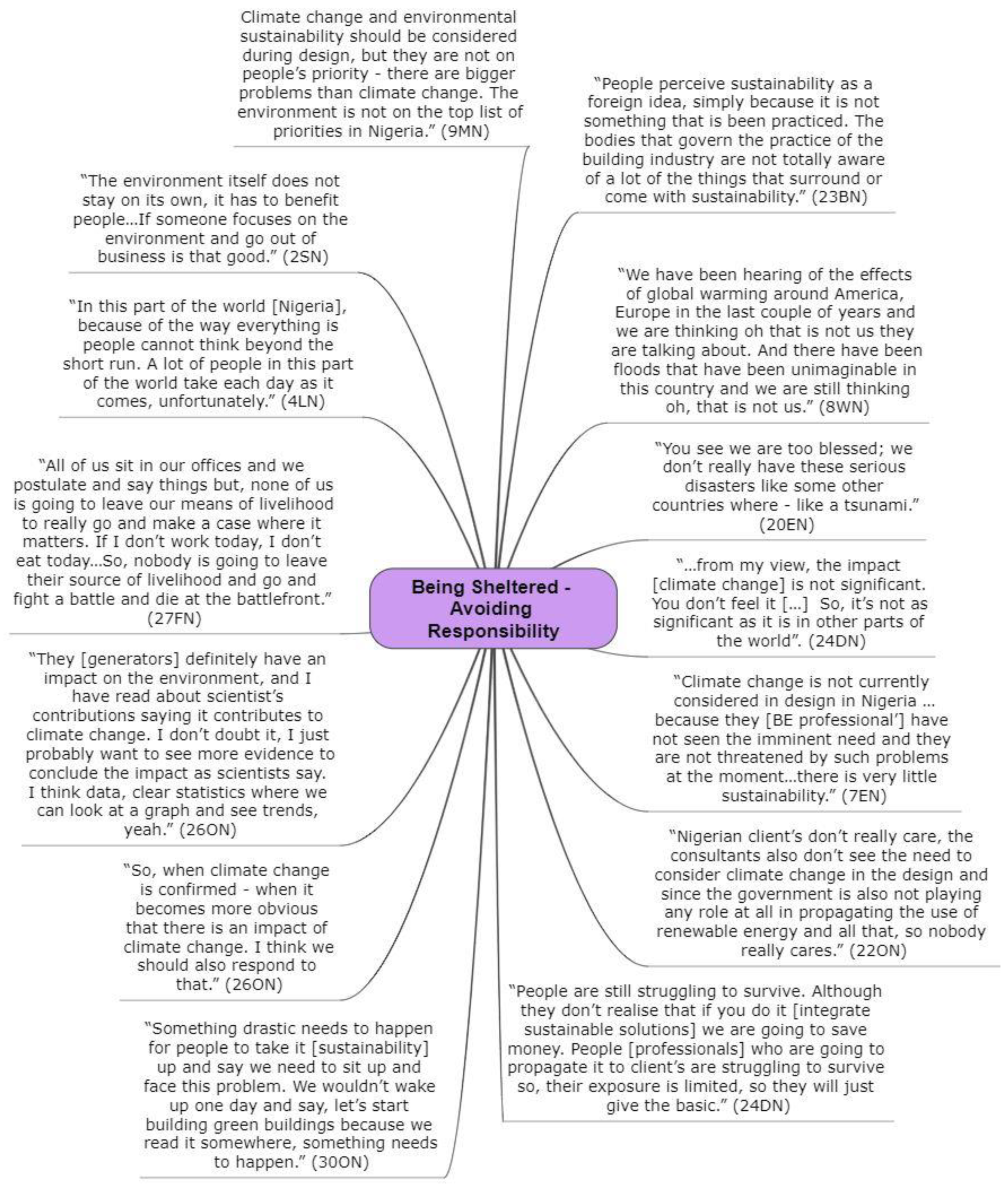
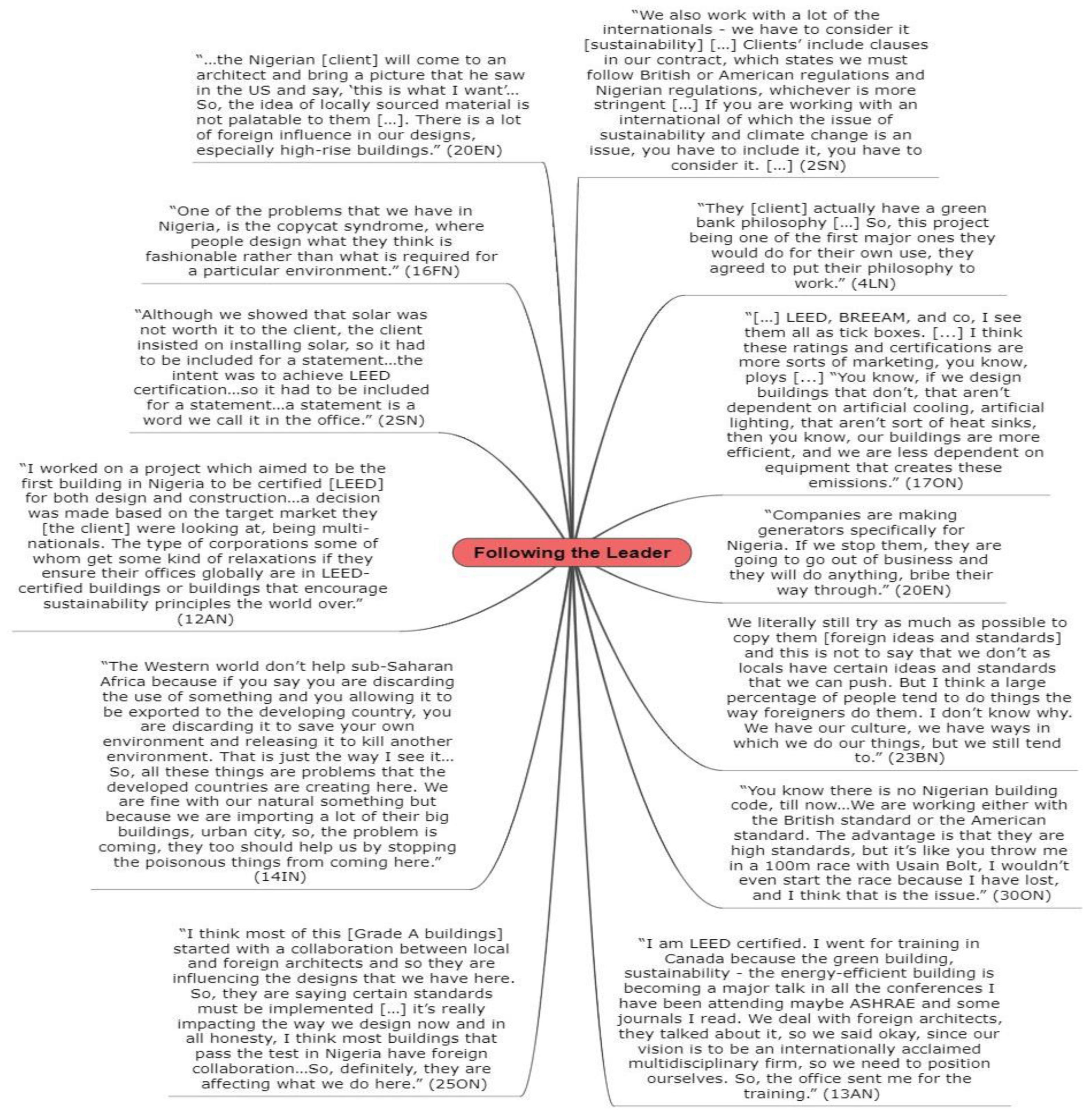

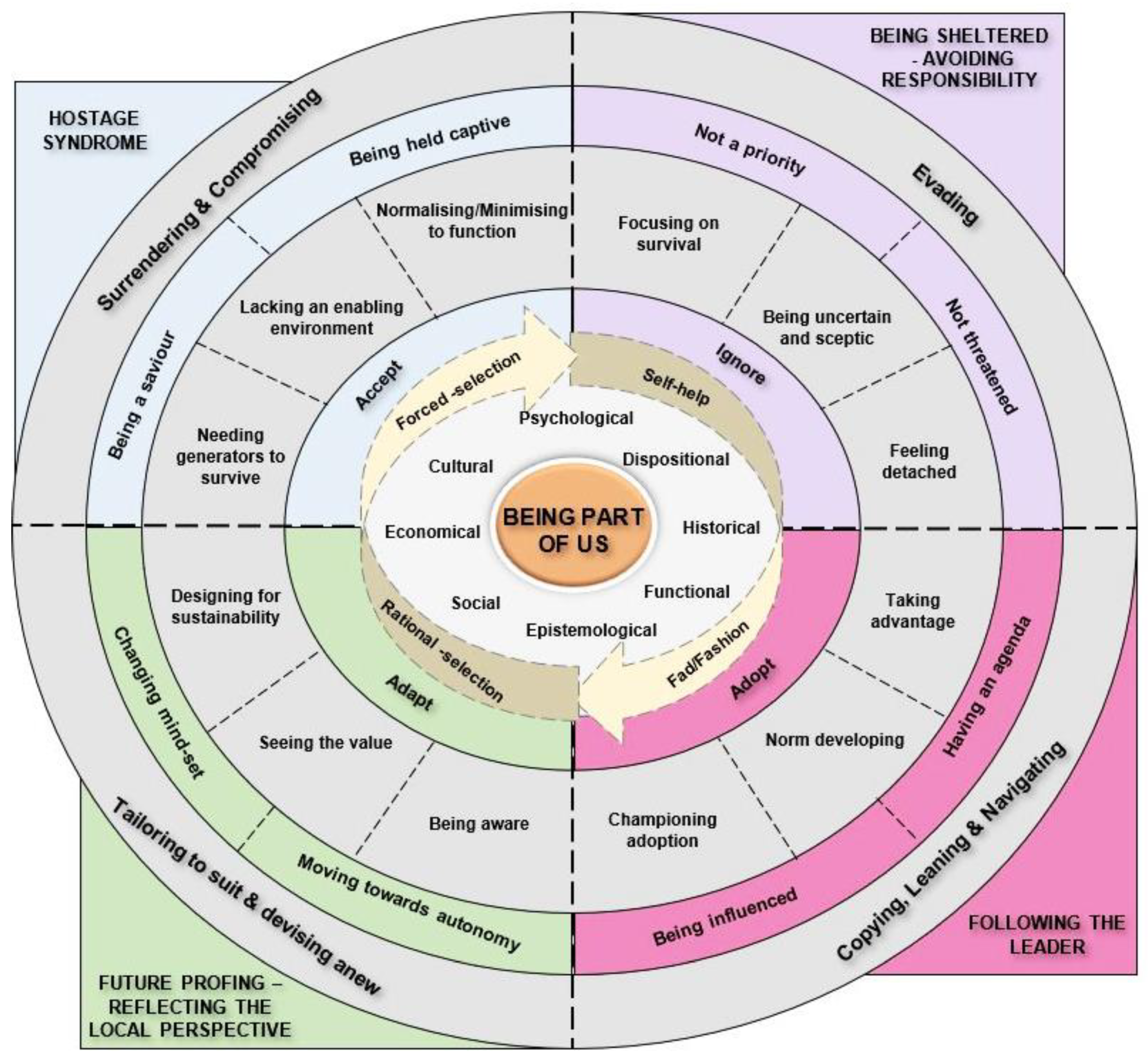
| Country | Population (2018 Estimate, in Millions) | Electricity Consumption 1971 (kWh/Capita) | Electricity Consumption 2018 (kWh/Capita) | Population without Access to Electricity 2017 (Estimate, in Millions) | Total Power Capacity 2016 (Million kWh) (Installed Generating Capacity) |
|---|---|---|---|---|---|
| Pakistan | 207.86 | 94 | 444 | 52 | 26.9 |
| Nigeria | 203.50 | 28 | 126 | 77 | 10.52 |
| Bangladesh | 159.45 | 11 | 336 | 60.3 (2013) | 11.9 |
| Egypt | 99.41 | 203 | 1606 | 0 | 45.12 |
| United Kingdom | 65.11 | 4255 | 4749 | 0 | 97.06 |
| South Africa | 55.38 | 2246 | 3740 | 9 | 50.02 |
| Ghana | 28.10 | 313 | 333 | 5 | 38.01 |
 | ||||
|---|---|---|---|---|
| Region | Power Outage Occurrence | Power Outage (Average Duration, h) 2015 | Firms Experiencing Power Outages (%) | Firms Owning/ Sharing Generators (%) |
| Sub-Saharan Africa | 253 | 741 | 78.7 | 53.2 |
| South Asia | 99 | 217 | 66.2 | 45.4 |
| Middle East and North Africa | 70 | 160 | 53.4 | 38.2 |
| Latin America and Caribbean | 15 | 27 | 64.1 | 27.1 |
| East Asia and Pacific | 12 | 26 | 45.9 | 32.5 |
| Europe and Central Asia | 7 | 12 | 37.9 | 17.2 |
| OECD high-income | 1 | 1 | - | - |
| Discipline | |
|---|---|
| Architect Mechanical engineer Electrical engineer Structural engineer Facilities manager Project manager | 16 5 6 3 2 2 |
| Years in practice | |
| 1–10 11–20 21–30 31–40 41–50 | 3 11 6 9 5 |
| Qualification | |
| HND Undergraduate Postgraduate (Masters) Doctorate | 1 15 16 2 |
| Excerpts from Transcripts | Initial Coding | Focused Coding | Category |
|---|---|---|---|
| “There is that general notion of as we use the local term ‘a cabal’ that operates the generating sector at least as regards generators that would always ensure the sale of generators is not affected”. | Believing that there is a generator cabal Ensuring generator continuation | Cabal/cartel | Exploiting and undermining systems |
| “But sadly, the government policy just wants someone to sign, most times the work doesn’t get done, and even if it gets done it’s not thoroughly done. So, if your EIA is not done properly then it’s easier to just, I mean get it done somehow you know. Have a quick exchange…”. | Expressing disappointment Lacking stringent policies and rules Being easier to bribe officials to get things done | Non-compliance Corruption | |
| “He now wanted us as a government to take it over and build so many but, because of corruption, because if there is nothing that will go back to those that will approve this thing, they ignored it”. | Lacking government support due to corruption Not approving the project without a bribe | Corruption | |
| “People are born into some of these smells, and they are totally immune, they can’t even smell, they can’t tell the difference anymore”. | Being born into pollution/polluted environments Being accustomed to pollution/polluted environments Building immunity over time | Living with pollution | Co-existing |
| “If in this estate now, there is no light and everywhere has a generator on and you walk around apart from the sound, the noise, the-you have been living with generators for years, so you don’t even know-unless you go to somewhere else that is quite…”. | Living with a generator Being accustomed to generators | Living with generators | |
| “Generators from the point of view of the environment is a very big liability to Nigeria but without generators, I would say that there would virtually be no Nigeria”. | Being an environmental liability No country without generators | Being a threat Being a saviour | Being a threat and a saviour |
| “I think they [professionals] in Nigeria have just thrown in the towel. You know, I think they have accepted to a certain extent the dysfunction […] so, it is a case of look we need to make the best of a bad situation. We need to just make this work the best we can and move on”. | Throwing in the towel Accepting dysfunction (the status quo) Making the best of a bad situation | Giving up/surrendering | Accepting impotence and fatalism |
| Phase 1 | Phase 2 | |||
|---|---|---|---|---|
| Excerpts | Initial Coding | Focused Coding | Initial Coding | Excerpts |
| “We use the British standards, there is a Nigerian building code, but it is not fully resolved a mix of various things”. | Using British standards Unresolved Nigerian building code | Norm developing (copying foreign systems) | Adopting standards based on convenience Nigerian standards are foreign standards | “The standards that we use are the convenient standards that we’ve usually gotten from the US, UK, maybe China. I mean just what is convenient, they never go through and then I mean that is what is termed as a Nigerian standard”. |
| “Designing for generators is the basic reality. It’s in your face every day at home and work, with regular bills for diesel purchase. It cannot be avoided”. | Designing for generators is an unavoidable reality Being a prevalent feature in everyday life Implying that generators are a constant financial drain | Creating a sense of normality (accepting/maintaining the status quo) Designing for generators Being part of us | Being unavoidable to design without generators Being a part of buildings | “Absolutely. Generators are designed for in a building. You can’t escape it; you end up with big generator blocks in most buildings”. |
| “People don’t feel threatened because the changes are so incremental…but it does happen over a protracted period”. | Not threatened by what is not seen/felt Not noticing incremental changes | Not threatened | Being blessed with the weather Not experiencing natural disasters like other countries | “You see we are too blessed; we don’t really have these serious disasters like some other countries where-like a tsunami”. |
| “You always need the trendsetter […] the moment it becomes a trend, you get a lot of offtakes”. | Needing trendsetters to encourage adoption Promoting adoption through examples | Having trendsetters Self-experiencing | Being convinced by real examples/posterboard projects Seeing/experiencing to believe and adopt | “I think a lot of people are convinced by real-life examples. They have got to see it work. […] Then when you do that, and everybody will now want a solar glass building. It’s what happens”. |
| Core Category: Being Part of Us | |||
|---|---|---|---|
| Category 1 | Category 2 | Category 3 | Category 4 |
| Hostage Syndrome | Being Sheltered—Avoiding Responsibility | Following the Leader | Future-Proofing—Reflecting the Local Perspective |
|
|
|
|
Publisher’s Note: MDPI stays neutral with regard to jurisdictional claims in published maps and institutional affiliations. |
© 2022 by the authors. Licensee MDPI, Basel, Switzerland. This article is an open access article distributed under the terms and conditions of the Creative Commons Attribution (CC BY) license (https://creativecommons.org/licenses/by/4.0/).
Share and Cite
Unuigbe, M.; Zulu, S.L.; Johnston, D. Exploring Factors Influencing Renewable Energy Diffusion in Commercial Buildings in Nigeria: A Grounded Theory Approach. Sustainability 2022, 14, 9726. https://doi.org/10.3390/su14159726
Unuigbe M, Zulu SL, Johnston D. Exploring Factors Influencing Renewable Energy Diffusion in Commercial Buildings in Nigeria: A Grounded Theory Approach. Sustainability. 2022; 14(15):9726. https://doi.org/10.3390/su14159726
Chicago/Turabian StyleUnuigbe, Maria, Sambo Lyson Zulu, and David Johnston. 2022. "Exploring Factors Influencing Renewable Energy Diffusion in Commercial Buildings in Nigeria: A Grounded Theory Approach" Sustainability 14, no. 15: 9726. https://doi.org/10.3390/su14159726
APA StyleUnuigbe, M., Zulu, S. L., & Johnston, D. (2022). Exploring Factors Influencing Renewable Energy Diffusion in Commercial Buildings in Nigeria: A Grounded Theory Approach. Sustainability, 14(15), 9726. https://doi.org/10.3390/su14159726







